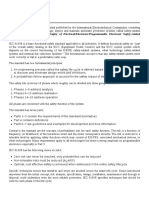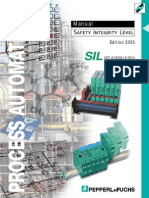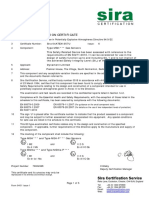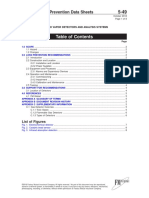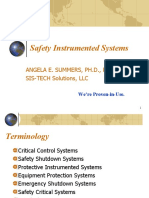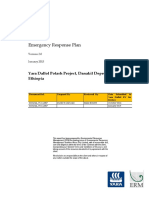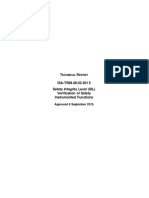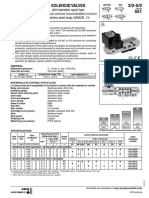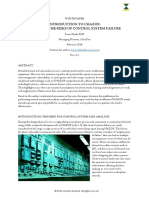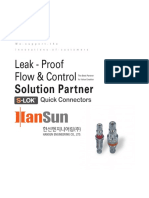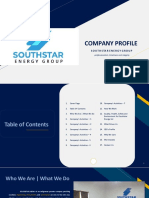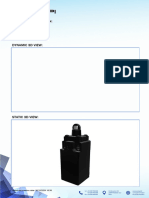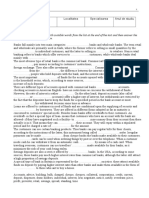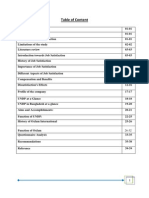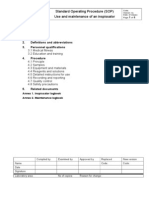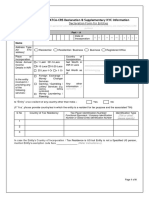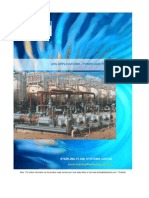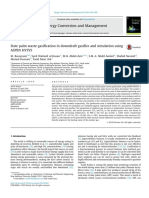Isa 92.00.01
Isa 92.00.01
Uploaded by
Dennis PeterCopyright:
Available Formats
Isa 92.00.01
Isa 92.00.01
Uploaded by
Dennis PeterOriginal Title
Copyright
Available Formats
Share this document
Did you find this document useful?
Is this content inappropriate?
Copyright:
Available Formats
Isa 92.00.01
Isa 92.00.01
Uploaded by
Dennis PeterCopyright:
Available Formats
--`,,```,,,,````-`-`,,`,,`,`,,`---
AMERICAN NATIONAL STANDARD
ANSI/ISA-92.00.01-2010 (R2015)
Performance Requirements
for Toxic Gas Detectors
Reaffirmed 10 July 2015
Provided by Accuris Licensee=/, User=,
No reproduction or networking permitted without license from Accuris Not for Resale,
--`,,```,,,,````-`-`,,`,,`,`,,`---
ANSI/ISA-92.00.01-2010 (R2015)
Performance Requirements for Toxic Gas Detectors
ISBN: 978-1-941546-60-4
Copyright © 2015 by ISA. All rights reserved. Not for resale. Printed in the United States of America.
No part of this publication may be reproduced, stored in a retrieval system, or transmitted in any form or
by any means (electronic mechanical, photocopying, recording, or otherwise), without the prior written
permission of the Publisher.
ISA
67 Alexander Drive
P.O. Box 12277
Research Triangle Park, North Carolina 27709
Provided by Accuris Licensee=/, User=,
No reproduction or networking permitted without license from Accuris Not for Resale,
ISA - International Society of Automation
ANSI/ISA 920001-2010 (R2015)
Second Edition
Underwriters Laboratories Inc.
ANSI/UL 920001
Second Edition
Performance Requirements for Toxic Gas Detectors
December 23, 2010
(Title Page Reprinted: July 10, 2015)
--`,,```,,,,````-`-`,,`,,`,`,,`---
ANSI/ISA/UL 920001-2010 (R2015)
Provided by Accuris Licensee=/, User=,
No reproduction or networking permitted without license from Accuris Not for Resale,
UL Standard for Safety for Performance Requirements for Toxic Gas
Detectors, UL 920001
Second Edition, Dated December 23, 2010
Summary of Topics
Adoption of ANSI/ISA 920001, Standard for Performance Requirements for Toxic Gas Detectors as
ANSI/UL 920001. This Standard is being issued to update the title page to reflect the reaffirmation of its
ANSI approval. No changes in requirements have been made.
Although this is the first-time publication of this Standard by UL, it is being published as the Second
edition in order to align UL’s edition number with that of the ISA Standard. Please note that as this is a
simple reaffirmation of an existing ISA standard.
These requirements are substantially in accordance with Proposal(s) on this subject dated May 8, 2015.
All rights reserved. No part of this publication may be reproduced, stored in a retrieval system, or
transmitted in any form by any means, electronic, mechanical photocopying, recording, or otherwise
without prior permission of UL.
UL provides this Standard "as is" without warranty of any kind, either expressed or implied, including but
not limited to, the implied warranties of merchantability or fitness for any purpose.
In no event will UL be liable for any special, incidental, consequential, indirect or similar damages,
including loss of profits, lost savings, loss of data, or any other damages arising out of the use of or the
inability to use this Standard, even if UL or an authorized UL representative has been advised of the
--`,,```,,,,````-`-`,,`,,`,`,,`---
possibility of such damage. In no event shall UL's liability for any damage ever exceed the price paid for
this Standard, regardless of the form of the claim.
Users of the electronic versions of UL's Standards for Safety agree to defend, indemnify, and hold UL
harmless from and against any loss, expense, liability, damage, claim, or judgment (including reasonable
attorney's fees) resulting from any error or deviation introduced while purchaser is storing an electronic
Standard on the purchaser's computer system.
The requirements in this Standard are now in effect, except for those paragraphs, sections, tables,
figures, and/or other elements of the Standard having future effective dates as indicated in the preface.
The prior text for requirements that have been revised and that have a future effective date are located
after the Standard, and are preceded by a "SUPERSEDED REQUIREMENTS" notice.
Provided by Accuris Licensee=/, User=,
No reproduction or networking permitted without license from Accuris Not for Resale,
Commitment for Amendments
This standard is issued jointly by ISA and Underwriters Laboratories Incorporated (UL). Comments or
proposals for revisions on any part of the standard may be submitted to UL at any time.
ISBN 978-1-941546-31-4 Copyright © 2015 ISA
All rights reserved. Not for resale. Printed in the United States of America. No part of this publication may
be reproduced, stored in a retrieval system, or transmitted in any form or by any means (electronic
mechanical, photocopying, recording, or otherwise), without the prior written permission of the Publisher.
The most recent designation of ANSI/ISA-92.00.01 as a Reaffirmed American National Standard (ANSI)
occurred on July 10, 2015.
Copyright © 2015 Underwriters Laboratories Inc.
UL's Standards for Safety are copyrighted by UL. Neither a printed nor electronic copy of a Standard
should be altered in any way. All of UL's Standards and all copyrights, ownerships, and rights regarding
those Standards shall remain the sole and exclusive property of UL.
This ANSI/UL Standard for Safety consists of the Second Edition including revisions through July 10,
2015.
The most recent designation of ANSI/UL 920001 as a Reaffirmed American National Standard (ANS)
occurred on July 10, 2015. ANSI approval for a standard does not include the Cover Page, Transmittal
Pages, Title Page, (front and back), or the Preface.
Comments or proposals for revisions on any part of the Standard may be submitted to UL at any time.
Proposals should be submitted via a Proposal Request in UL's On-Line Collaborative Standards
Development System (CSDS) at http://csds.ul.com.
UL's Standards for Safety are copyrighted by UL. Neither a printed nor electronic copy of a Standard
should be altered in any way. All of UL's Standards and all copyrights, ownerships, and rights regarding
those Standards shall remain the sole and exclusive property of UL.
To purchase UL Standards, visit Comm 2000 at http://www.comm-2000.com/help/how_to_order.aspx or
call toll-free 1-888-853-3503.
--`,,```,,,,````-`-`,,`,,`,`,,`---
Provided by Accuris Licensee=/, User=,
No reproduction or networking permitted without license from Accuris Not for Resale,
General Notes
This is the common ISA and UL, Standard for the Performance Requirements for Toxic Gas Detectors. It
is the second edition of ANSI/ISA-92.00.01 and the second edition of ANSI/UL 920001. The document is
a modification of the ISA document to create the equivalent UL version and maintain the ANSI approval of
this standard.
ANSI/ISA-92.00.01 and ANSI/UL 920001 contain identical requirements, and identical publication dates.
Efforts have been made to synchronize the UL edition number with that of the corresponding ISA
standard with which this standard is harmonized. As a result, one or more UL edition numbers have been
skipped to match that of the ISA edition number.
This common standard was prepared by the (ISA) - The International Society of Automation on December
23, 2010 but is now being maintained by Underwriters Laboratories Inc. (UL).
Note: Although the intended primary application of this standard is stated in its scope, it is
important to note that it remains the responsibility of the users of the standard to judge its suitability
for their particular purpose.
UL Effective Date
The requirements in this standard are in effect.
A UL effective date is one established by Underwriters Laboratories Inc. and is not part of the ANSI
approved standard.
--`,,```,,,,````-`-`,,`,,`,`,,`---
Provided by Accuris Licensee=/, User=,
No reproduction or networking permitted without license from Accuris Not for Resale,
9 ANSI/ISA-92.00.01-2010 (R2015) ♦ ANSI/UL 920001 December 23, 2010
Preface
This preface, as well as all footnotes and annexes, is included for information purposes and is not part of
ANSI/ISA-92.00.01-2010 (R2015).
This document has been prepared as part of the service of ISA towards a goal of uniformity in the field of
instrumentation. To be of real value, this document should not be static but should be subject to periodic
review. Toward this end, the Society welcomes all comments and criticisms and asks that they be
addressed to the Secretary, Standards and Practices Board; ISA; 67 Alexander Drive; P. O. Box 12277;
Research Triangle Park, NC 27709; Telephone (919) 549-8411; Fax (919) 549-8288; E-mail:
standards@isa.org.
--`,,```,,,,````-`-`,,`,,`,`,,`---
The ISA Standards and Practices Department is aware of the growing need for attention to the metric
system of units in general, and the International System of Units (SI) in particular, in the preparation of
instrumentation standards. The Department is further aware of the benefits to USA users of ISA
standards of incorporating suitable references to the SI (and the metric system) in their business and
professional dealings with other countries. Toward this end, this Department will endeavor to introduce
SI-acceptable metric units in all new and revised standards, recommended practices, and technical
reports to the greatest extent possible. Standard for Use of the International System of Units (SI): The
Modern Metric System, published by the American Society for Testing & Materials as IEEE/ASTM SI 10-
97, and future revisions, will be the reference guide for definitions, symbols, abbreviations, and
conversion factors.
It is the policy of ISA to encourage and welcome the participation of all concerned individuals and
interests in the development of ISA standards, recommended practices, and technical reports.
Participation in the ISA standards-making process by an individual in no way constitutes endorsement by
the employer of that individual, of ISA, or of any of the standards, recommended practices, and technical
reports that ISA develops.
CAUTION — ISA DOES NOT TAKE ANY POSITION WITH RESPECT TO THE EXISTENCE OR
VALIDITY OF ANY PATENT RIGHTS ASSERTED IN CONNECTION WITH THIS DOCUMENT, AND
ISA DISCLAIMS LIABILITY FOR THE INFRINGEMENT OF ANY PATENT RESULTING FROM THE
USE OF THIS DOCUMENT. USERS ARE ADVISED THAT DETERMINATION OF THE VALIDITY OF
ANY PATENT RIGHTS, AND THE RISK OF INFRINGEMENT OF SUCH RIGHTS, IS ENTIRELY THEIR
OWN RESPONSIBILITY.
PURSUANT TO ISA’S PATENT POLICY, ONE OR MORE PATENT HOLDERS OR PATENT
APPLICANTS MAY HAVE DISCLOSED PATENTS THAT COULD BE INFRINGED BY USE OF THIS
DOCUMENT AND EXECUTED A LETTER OF ASSURANCE COMMITTING TO THE GRANTING OF A
LICENSE ON A WORLDWIDE, NON-DISCRIMINATORY BASIS, WITH A FAIR AND REASONABLE
ROYALTY RATE AND FAIR AND REASONABLE TERMS AND CONDITIONS. FOR MORE
INFORMATION ON SUCH DISCLOSURES AND LETTERS OF ASSURANCE, CONTACT ISA OR
VISIT WWW.ISA.ORG/STANDARDSPATENTS.
OTHER PATENTS OR PATENT CLAIMS MAY EXIST FOR WHICH A DISCLOSURE OR LETTER OF
ASSURANCE HAS NOT BEEN RECEIVED. ISA IS NOT RESPONSIBLE FOR IDENTIFYING PATENTS
OR PATENT APPLICATIONS FOR WHICH A LICENSE MAY BE REQUIRED, FOR CONDUCTING
INQUIRIES INTO THE LEGAL VALIDITY OR SCOPE OF PATENTS, OR DETERMINING WHETHER
ANY LICENSING TERMS OR CONDITIONS PROVIDED IN CONNECTION WITH SUBMISSION OF A
LETTER OF ASSURANCE, IF ANY, OR IN ANY LICENSING AGREEMENTS ARE REASONABLE OR
NON-DISCRIMINATORY.
Provided by Accuris Licensee=/, User=,
No reproduction or networking permitted without license from Accuris Not for Resale,
10 ANSI/ISA-92.00.01-2010 (R2015) ♦ ANSI/UL 920001 December 23, 2010
ISA REQUESTS THAT ANYONE REVIEWING THIS DOCUMENT WHO IS AWARE OF ANY PATENTS
THAT MAY IMPACT IMPLEMENTATION OF THE DOCUMENT NOTIFY THE ISA STANDARDS AND
PRACTICES DEPARTMENT OF THE PATENT AND ITS OWNER.
ADDITIONALLY, THE USE OF THIS DOCUMENT MAY INVOLVE HAZARDOUS MATERIALS,
OPERATIONS OR EQUIPMENT. THE DOCUMENT CANNOT ANTICIPATE ALL POSSIBLE
APPLICATIONS OR ADDRESS ALL POSSIBLE SAFETY ISSUES ASSOCIATED WITH USE IN
HAZARDOUS CONDITIONS. THE USER OF THIS DOCUMENT MUST EXERCISE SOUND
PROFESSIONAL JUDGMENT CONCERNING ITS USE AND APPLICABILITY UNDER THE USER’S
PARTICULAR CIRCUMSTANCES. THE USER MUST ALSO CONSIDER THE APPLICABILITY OF
ANY GOVERNMENTAL REGULATORY LIMITATIONS AND ESTABLISHED SAFETY AND HEALTH
PRACTICES BEFORE IMPLEMENTING THIS DOCUMENT.
THE USER OF THIS DOCUMENT SHOULD BE AWARE THAT THIS DOCUMENT MAY BE IMPACTED
BY ELECTRONIC SECURITY ISSUES. THE COMMITTEE HAS NOT YET ADDRESSED THE
POTENTIAL ISSUES IN THIS VERSION.
The following people served as members of ISA Committee ISA92:
NAME COMPANY
J. Miller, Chair Detector Electronics Corporation
R. Seitz, Vice Chair Artech Engineering
M. Coppler, Managing Director Ametek Inc.
S. Baliga General Monitors
W. Bennett Mine Safety Appliances Co.
J. Berthold Senscient Inc.
G. Garcha GE Energy
R. Goins Lyondell Basell
K. Hedrick MSHA Approval & Certification Center
S. Henney FM Approvals
R. Masi Detcon Inc.
D. Mills Underwriters Laboratories Inc.
A. Spataru Adept Group Inc.
J. Stratman Honeywell Analytics Inc.
J. Thomason Omni Industrial Systems Inc.
A. Vial Shell Exploration & Production Co.
D. Wechsler Dow Chemical Co.
This standard was approved for publication by the ISA Standards and Practices Board on 23 December
2010.
NAME COMPANY
J. Tatera Tatera & Associates Inc.
P. Brett Honeywell Inc.
M. Coppler Ametek Inc.
E. Cosman The Dow Chemical Company
B. Dumortier Schneider Electric
--`,,```,,,,````-`-`,,`,,`,`,,`---
D. Dunn Aramco Services Co.
R. Dunn DuPont Engineering
J. Gilsinn NIST/MEL
E. Icayan ACES Inc.
J. Jamison EnCana Corporation Ltd.
D. Kaufman Honeywell International Inc.
K. P. Lindner Endress + Hauser Process Solutions AG
Provided by Accuris Licensee=/, User=,
No reproduction or networking permitted without license from Accuris Not for Resale,
11 ANSI/ISA-92.00.01-2010 (R2015) ♦ ANSI/UL 920001 December 23, 2010
V. Maggioli Feltronics Corp.
T. McAvinew Jacobs Engineering
A. McCauley Chagrin Valley Controls Inc.
R. Reimer Rockwell Automation
N. Sands DuPont
H. Sasajima Yamatake Corp.
T. Schnaare Rosemount Inc.
I. Verhappen Industrial Automation Networks Inc.
R. Webb ICS Secure LLC
W. Weidman Consultant
J. Weiss Applied Control Solutions LLC
M. Widmeyer Kahler Engineering Inc.
M. Wilkins Yokogawa IA Global Marketing (USMK)
M. Zielinski Emerson Process Management
--`,,```,,,,````-`-`,,`,,`,`,,`---
Provided by Accuris Licensee=/, User=,
No reproduction or networking permitted without license from Accuris Not for Resale,
13 ANSI/ISA-92.00.01-2010 (R2015) ♦ ANSI/UL 920001 December 23, 2010
Contents
1 Scope ................................................................................................................................ 15
2 References ........................................................................................................................ 15
3 Definitions ......................................................................................................................... 15
4 General requirements ....................................................................................................... 18
4.1 General ............................................................................................................................. 18
4.2 Indicating devices (audible, visual and display) ................................................................ 19
4.3 Switches and outputs ........................................................................................................ 20
4.4 Alarm signal ...................................................................................................................... 20
4.5 Fault signals ...................................................................................................................... 21
4.6 Adjustments ...................................................................................................................... 21
4.7 Construction ...................................................................................................................... 22
4.8 Stand-alone gas detection apparatus for use with separate control units ........................ 22
4.9 Stand-alone control units for use with stand-alone gas detection apparatus ................... 22
4.10 Communication options .................................................................................................... 23
4.11 Gas detection apparatus as part of systems .................................................................... 23
4.12 Labeling and marking ........................................................................................................ 23
4.13 Instruction manual ............................................................................................................. 24
5 Test methods .................................................................................................................... 26
5.1 Introduction ....................................................................................................................... 26
5.2 General requirements for test ........................................................................................... 26
5.3 Preparation of the apparatus ............................................................................................ 27
5.4 Conditions for test and test area ....................................................................................... 27
5.5 Unpowered storage ........................................................................................................... 29
5.6 Drop test (portable and transportable only) ...................................................................... 29
5.7 Vibration ............................................................................................................................ 29
5.8 Initial calibration and set-up .............................................................................................. 30
5.9 Accuracy ........................................................................................................................... 30
5.10 Fault signals ...................................................................................................................... 31
5.11 Repeatability ..................................................................................................................... 31
5.12 Consumables .................................................................................................................... 31
5.13 Step-change response and recovery ................................................................................ 32
5.14 Supply voltage variation .................................................................................................... 32
5.15 Temperature variation ....................................................................................................... 34
5.16 Humidity variation.............................................................................................................. 35
5.17 Position sensitivity ............................................................................................................. 35
5.18 Air velocity variation .......................................................................................................... 35
5.19 Long-term stability ............................................................................................................. 36
5.20 Battery and low-battery voltage alarm .............................................................................. 38
5.21 Exposure to high-concentration gas ................................................................................. 39
Annex A —Applicability & acceptance criteria (Normative) ........................................................................ 41
--`,,```,,,,````-`-`,,`,,`,`,,`---
Provided by Accuris Licensee=/, User=,
No reproduction or networking permitted without license from Accuris Not for Resale,
15 ANSI/ISA-92.00.01-2010 (R2015) ♦ ANSI/UL 920001 December 23, 2010
CAUTION—EXPOSURE TO TOXIC GASES MAY BE HAZARDOUS TO HEALTH AND LIFE.
1 Scope
1.1 This standard provides minimum requirements for the construction, performance, and testing of
portable, transportable, mobile, and stationary electrical apparatus whose purpose is for the detection,
measurement and notification of toxic gas in air that are used to enhance the safety of personnel in
commercial and industrial locations.
NOTE 1 — Laboratory- or scientific-type analysis or process control performance requirements are not part of this standard.
a) Residential locations are outside the scope of this standard.
NOTE 2 — Performance requirements for detection of flammable (explosive) concentrations of toxic gas(es) are not the purpose of
this standard.
NOTE 3 — The user should be aware of environmental effects on both the apparatus and the toxic gas. The effects are not
intended to be evaluated by this standard.
Hereafter, the term “apparatus” will refer to “gas-detection apparatus.”
2 References
ANSI/ISA-12.13.01, Performance Requirements for Combustible Gas Detectors
ISA-RP92.0.02, Installation, Operation, and Maintenance of Toxic Gas-Detection Instruments: Hydrogen
Sulfide (recommended practice for this standard), establishes user criteria for the installation, operation,
and maintenance of toxic gas-detection instruments
ANSI/ISA-92.04.01, Performance Requirements for Instruments Used to Detect Oxygen-
Deficient/Oxygen-Enriched Atmospheres
National Institute for Occupational Safety and Health (NIOSH) Pocket Guide to Chemical Hazards, Title
29, Part 1910.1000, Occupational Safety and Health Standards
Threshold Limit Values for Chemical Substances in the Work Environment Adopted by the American
Conference of Governmental Industrial Hygienists (ACGIH)
Documentation for Immediately Dangerous to Life or Health Concentrations (IDLHs) (NIOSH Taft
Laboratories)
EN 50270, Electromagnetic Compatibility - Electrical Apparatus for the Detection and Measurement of
Combustible Gases, Toxic Gases or Oxygen
3 Definitions
For the purposes of this standard, the following definitions apply:
3.1 alarm:
an audible, visual, or physical signal that alerts the instrument user of a dangerous gas concentration or
instrument problem
3.1.1 false alarm:
any alarm that is triggered by a condition other than the one(s) that the alarm function is set for (ex: high
gas alarm caused by RF interference or gas alarm caused by temperature changes)
--`,,```,,,,````-`-`,,`,,`,`,,`---
Provided by Accuris Licensee=/, User=,
No reproduction or networking permitted without license from Accuris Not for Resale,
16 ANSI/ISA-92.00.01-2010 (R2015) ♦ ANSI/UL 920001 December 23, 2010
3.2 alarm-only apparatus:
apparatus having an alarm, but not having a meter or other indicating device.
3.3 alarm setpoint:
the selected gas concentration level(s) at which an alarm is activated.
3.4 ambient air:
air to which the sensing element is normally exposed.
3.5 bump test
application of test gas or other means of obtaining a response from the sensor to check its function. This
may include the generation of an alarm. This check is performed without adjustments of sensitivity.
NOTE This is also known as a “response check” or “functional check”.
3.6 calibration:
the procedure to adjust the apparatus for proper response (e.g., zero level, span, alarm, and range).
3.7 calibration gas:
the known concentration(s) of gas used to set the apparatus span or alarm level(s).
3.8 clean air:
air that is free of any substance that will adversely affect the operation of or cause a response from the
apparatus.
3.9 consumables:
materials or components that are depleted or require periodic replacement through normal use of the
apparatus.
3.10 control unit:
that portion of a gas detection apparatus that is not directly responsive to the gas, but which responds to
the electrical signal obtained from one or more detector heads. This unit is intended to provide meter
indication, alarm functions, output contacts and/or alarm signal outputs when utilized with a detector
head.
3.11 detector head:
the gas responsive portion of a gas detection apparatus located in the area where sensing the presence
of gas is desired. It may be integral with or removed from its control unit.
NOTE The detector head may incorporate, in the same housing, circuitry such as signal processing or amplifying components or
circuits in addition to the gas sensing element (sensor).
3.12 diffusion:
a process by which the atmosphere being monitored is transported by natural random molecular
movement to and from the gas-sensing element.
3.13 field check with gas (response check):
application of test gas to the sensor to check the response signal or the generation of an alarm, without
adjustments of zero, sensitivity, or alarm level.
3.14 full-scale:
the maximum claimed operational level of the gas-detection apparatus.
3.15 gas-detection apparatus:
an assembly of electrical and mechanical components (either a single integrated unit or a system
comprised of two or more physically separate but interconnected component parts) which senses the
presence of a gas and responds by providing an alarm, indication, or other output functions.
--`,,```,,,,````-`-`,,`,,`,`,,`---
Provided by Accuris Licensee=/, User=,
No reproduction or networking permitted without license from Accuris Not for Resale,
17 ANSI/ISA-92.00.01-2010 (R2015) ♦ ANSI/UL 920001 December 23, 2010
3.16 gas-sensing element:
the particular subassembly or element in the gas-detection apparatus that, in the presence of a gas,
produces a change in its electrical, chemical, or physical characteristics.
3.17 indication:
a discrete communication of a measured value or alarm condition.
3.18 IDLH (Immediately Dangerous to Life and Health):
the maximum concentration from which, in the event of respirator failure, one could escape within 30
minutes without a respirator and without experiencing any escape-impairing (e.g., severe eye irritation) or
irreversible health effects.
3.19 mobile apparatus:
a continuous-monitoring apparatus mounted on a vehicle, such as, but not limited to, a mining machine or
industrial truck.
3.20 nominal voltage:
the voltage given by manufacturers as the recommended operating voltage of their gas detection
equipment. If a range (versus a specific voltage) is given, the nominal voltage shall be considered as the
midpoint of the range, unless otherwise specified.
3.21 PEL (Permissible Exposure Limit):
time-weighted average (TWA) concentration that must not be exceeded during any 8-hour work shift of a
40-hour work week, as defined by the Occupational Safety and Health Administration (OSHA).
--`,,```,,,,````-`-`,,`,,`,`,,`---
3.22 portable apparatus:
spot-reading or continuous duty apparatus that has been designed to be readily carried from place to
place and to be used while it is being carried. A portable apparatus is battery powered and includes, but
is not limited to
a) a hand-held apparatus, typically less than 1 kg, suitable for single-handed operation;
b) personal monitors, similar in size and mass to the hand-held apparatus, that are continuously
operating (but not necessarily continuously sensing) while they are attached to the user; and
c) larger apparatus that can be operated by the user while it is suspended by hand, by a shoulder strap
or by a carrying harness; it may or may not have a hand directed probe.
3.23 REL (Recommended Exposure Limit):
exposure levels that are safe for various periods of employment, including but not limited to the exposure
levels at which no employee will suffer impaired health or functional capacities or diminished life
expectancy as a result of that work experience.
3.24 range:
the values of concentrations of toxic gas over which accuracy is ensured by calibration.
3.25 spot-reading apparatus:
apparatus intended to be used for short periods of time as required (typically 5 min or less).
3.26 sample-draw:
a method to cause deliberate flow of the atmosphere being monitored to a gas-sensing element.
3.27 signal-processing detector head:
an apparatus intended to be incorporated with separate signal processing, data acquisition, central
monitoring, or other similar systems in which the apparatus provides a conditioned electronic signal or
Provided by Accuris Licensee=/, User=,
No reproduction or networking permitted without license from Accuris Not for Resale,
18 ANSI/ISA-92.00.01-2010 (R2015) ♦ ANSI/UL 920001 December 23, 2010
output indication to systems of the aforementioned type that typically process information from various
locations and sources including, but not limited to, gas-detection apparatus.
3.28 span:
the algebraic difference between the upper and lower values of a range.
3.29 stabilization:
state when three successive readings of an apparatus, taken at intervals equal to the maximum t(90)
value defined in Annex A (Item 5), indicates no changes greater than the accuracy value defined in Annex
A (Item 2).
3.30 stationary apparatus:
a gas-detection apparatus intended for permanent installation in a fixed location.
3.31 (TLV-)STEL, (Threshold Limit Value-) Short-Term Exposure Limit:
a 15-minute Time-Weighted Average (TWA) exposure that should not be exceeded at any time during a
workday, even if the 8-hour TWA is within the Threshold Limit Value - Time-Weighted Average (TLV-
TWA).
3.32 test gas:
toxic gas diluted with clean air or inert gas to a known concentration within the test-gas tolerance stated in
Annex A, Item 1.
3.33 transportable apparatus:
apparatus not intended to be portable, but which can be moved readily from one place to another.
3.34 (TLV-)TWA, (Threshold Limit Value-) Time-Weighted Average:
the time-weighted average concentration for a normal 8-hour work day in a 40-hour work week, to which
nearly all workers may be repeatedly exposed, day after day, without adverse effect.
3.35 toxic gas:
toxic gases, for the purpose of this standard, are gases that may cause significant acute health effects at
low concentrations. Health effects may include severe skin or eye irritation, pulmonary edema,
neurotoxicity, or other potentially fatal conditions.
3.36 trouble signal:
information that alerts an apparatus user to abnormal conditions.
3.37 stand-alone gas detection apparatus:
a detector which provides a conditioned electronic signal or output indication to a system. The stand-
alone detector head is intended to be interfaced to unspecified separate control unit, signal processing
data acquisition, central monitoring, or other similar systems in which the apparatus provides a
conditioned electronic signal or output indication to systems.
3.38 stand-alone control unit:
fixed gas detection control units intended to provide meter indication, alarm functions, output contacts
and/or alarm signal outputs when utilized with stand-alone detector head.
4 General requirements
4.1 General
4.1.1 The gas detection apparatus shall be suitable for use in the intended location.
--`,,```,,,,````-`-`,,`,,`,`,,`---
Provided by Accuris Licensee=/, User=,
No reproduction or networking permitted without license from Accuris Not for Resale,
You might also like
- Iec 62443-3-3: 2020Document90 pagesIec 62443-3-3: 2020beyaco4448No ratings yet
- Isa-Tr84 00 07-2018Document106 pagesIsa-Tr84 00 07-2018ANo ratings yet
- Endangered Species of Plants & Animals in MaharashtraDocument18 pagesEndangered Species of Plants & Animals in Maharashtra27 Hardik Gosavi82% (17)
- Functional Safety Certificate: ICO3S, ICO4S, ICO4D, ICO4N and SOV 1 To 6Document5 pagesFunctional Safety Certificate: ICO3S, ICO4S, ICO4D, ICO4N and SOV 1 To 6Ignacio Benito100% (1)
- IEC 61508 Is An International Standard Published by The International Electrotechnical Commission ConsistingDocument7 pagesIEC 61508 Is An International Standard Published by The International Electrotechnical Commission Consistingyuth85pNo ratings yet
- Sil Manual PDFDocument44 pagesSil Manual PDFDerbel WalidNo ratings yet
- Isa RP60.2 1995Document24 pagesIsa RP60.2 1995Alexandre DiasNo ratings yet
- ANSI Gases Combustibles y VaporesDocument216 pagesANSI Gases Combustibles y VaporesHiram FloresNo ratings yet
- 12.13.01 - Performance Requirement For Combustible Gas DetecDocument38 pages12.13.01 - Performance Requirement For Combustible Gas DetecM Yusuf AminNo ratings yet
- 1 Sira 04ATEX1357U.iss 6Document6 pages1 Sira 04ATEX1357U.iss 6Juan Vargas Ferrer100% (1)
- DS59 IEC 60079 0 2011 The Differences and The ConsequencesDocument3 pagesDS59 IEC 60079 0 2011 The Differences and The ConsequencesGlen AshwellNo ratings yet
- IECEx OD504 Ed3.0Document67 pagesIECEx OD504 Ed3.0Bhavesh AroraNo ratings yet
- Is Iec 61508 0 2005Document21 pagesIs Iec 61508 0 2005Kailash Pandey100% (1)
- S - 92.06.01 Performance Requirements For Chlorine Detection Instruments (0.5 - 30 PPM Full Scale)Document38 pagesS - 92.06.01 Performance Requirements For Chlorine Detection Instruments (0.5 - 30 PPM Full Scale)milecsa100% (1)
- CDOIF Guideline Demonstrating Prior Use v7 FinalDocument34 pagesCDOIF Guideline Demonstrating Prior Use v7 Finaldwi rakhmatullahNo ratings yet
- ISA-TR84.00 Implementation PDFDocument84 pagesISA-TR84.00 Implementation PDFGabriel DoméNo ratings yet
- Cyber Security Implications of SIS Integration With Control NetworksDocument34 pagesCyber Security Implications of SIS Integration With Control Networksabdel taib100% (1)
- ISA-61241 Electrical Aparatus To Use in Zone21y22Document26 pagesISA-61241 Electrical Aparatus To Use in Zone21y22nicolascsNo ratings yet
- StandardsDocument2 pagesStandardsAdrian CandorNo ratings yet
- FMDS0549Document8 pagesFMDS0549Salvador NoeNo ratings yet
- Nema 250Document46 pagesNema 250Rodolfo Navarro RetanaNo ratings yet
- Back To Basics 02 - Safety Integrity Level (SIL) - ExidaDocument3 pagesBack To Basics 02 - Safety Integrity Level (SIL) - ExidaThiago FernandesNo ratings yet
- Safety Instrumented Systems: Angela E. Summers, PH.D., P.E. SIS-TECH Solutions, LLCDocument19 pagesSafety Instrumented Systems: Angela E. Summers, PH.D., P.E. SIS-TECH Solutions, LLCsayedNo ratings yet
- Ignition Model Ukooa Hse Ip JipDocument16 pagesIgnition Model Ukooa Hse Ip Jipsasankar_yh50% (2)
- ANSI ISA TR12.13.01 R2005 - Flammability Characteristics of Combustible Gases and VaporsDocument216 pagesANSI ISA TR12.13.01 R2005 - Flammability Characteristics of Combustible Gases and VaporsCesar Augusto Briceño EspinozaNo ratings yet
- IEC 61511 Based Design For Gas Detection Systems Monitoring Hydrocarbon Storage Tank SystemsDocument16 pagesIEC 61511 Based Design For Gas Detection Systems Monitoring Hydrocarbon Storage Tank Systemsarsil5840No ratings yet
- ISA-92.0.01 (1998) Part IDocument40 pagesISA-92.0.01 (1998) Part ISergio LungrinNo ratings yet
- Revised Guidelines For Formal Safety Assessment (Fsa) - Msc-Mepc 2-Circ 12-Rev 2Document71 pagesRevised Guidelines For Formal Safety Assessment (Fsa) - Msc-Mepc 2-Circ 12-Rev 2Martin NiNo ratings yet
- Emergency Response Plan: Yara Dallol Potash Project, Danakil Depression, EthiopiaDocument26 pagesEmergency Response Plan: Yara Dallol Potash Project, Danakil Depression, EthiopiaNaba majeadNo ratings yet
- SIL Products & Services: Redefining Flow ControlDocument16 pagesSIL Products & Services: Redefining Flow ControlsantoshjayantiNo ratings yet
- Tuev Rheinland Cyber Security en 2015Document2 pagesTuev Rheinland Cyber Security en 2015Miguel AngelNo ratings yet
- ANSI/ISA-TR12.06.01-1999: Electrical Equipment in A Class I, Division 2/zone 2 Hazardous LocationDocument18 pagesANSI/ISA-TR12.06.01-1999: Electrical Equipment in A Class I, Division 2/zone 2 Hazardous LocationRaul Roque YujraNo ratings yet
- HFT From IEC-En - 61511-1 CommentedDocument2 pagesHFT From IEC-En - 61511-1 Commenteddijoz85No ratings yet
- Common Cause and Common SenseDocument14 pagesCommon Cause and Common SenseRomel RodriguezNo ratings yet
- Annunciator Sequences and Specifications: ISA-18.1-1979 (R2004)Document54 pagesAnnunciator Sequences and Specifications: ISA-18.1-1979 (R2004)juliofelixNo ratings yet
- Introduction Chaz OpDocument44 pagesIntroduction Chaz Opguillermo_pacanins100% (1)
- Brochure: Control Hazard and Operability Study (CHAZOP) : Excellence in Dependable AutomationDocument2 pagesBrochure: Control Hazard and Operability Study (CHAZOP) : Excellence in Dependable AutomationDiegoNo ratings yet
- 13ansiisa-12 12 01-2011Document46 pages13ansiisa-12 12 01-2011marielaalmendrasNo ratings yet
- Isa-Tr84 00 02-2015Document136 pagesIsa-Tr84 00 02-2015Saïd NasriNo ratings yet
- Atex 7700e-185977Document9 pagesAtex 7700e-185977Bright OkunkpolorNo ratings yet
- ANSIISA 84.00.01-2004 and Existing Safety Instrumented SystemsDocument6 pagesANSIISA 84.00.01-2004 and Existing Safety Instrumented Systemsiman562No ratings yet
- ExSilentia User GuideDocument0 pagesExSilentia User Guidejeeva4384No ratings yet
- Windsonic - Campbell User ManualDocument46 pagesWindsonic - Campbell User ManualbluesxamNo ratings yet
- ISA-84.00.02 Part 2 (2002)Document44 pagesISA-84.00.02 Part 2 (2002)Sergio LungrinNo ratings yet
- Klaus Kroner HP Heft 1 2012 PDFDocument17 pagesKlaus Kroner HP Heft 1 2012 PDFSamNo ratings yet
- ISA - TR50.02 Part 9-2000 Fieldbus Standard For Use in Industrial Control Systems User Layer Technical ReportDocument996 pagesISA - TR50.02 Part 9-2000 Fieldbus Standard For Use in Industrial Control Systems User Layer Technical ReportSalvador MangioneNo ratings yet
- Application of IEC 60079-10-1 Edition 2.0 For Hazardous Area ClassificationDocument9 pagesApplication of IEC 60079-10-1 Edition 2.0 For Hazardous Area ClassificationEfari Bahchevan100% (1)
- EI PublicationsDocument64 pagesEI PublicationsAnonymous j5XYgIuNo ratings yet
- As 61508.5-2011 Functional Safety of Electrical Electronic Programmable Electronic Safety-Related Systems ExaDocument10 pagesAs 61508.5-2011 Functional Safety of Electrical Electronic Programmable Electronic Safety-Related Systems ExaSAI Global - APACNo ratings yet
- Solenoid Valves 3/2-5/2 551: Single/dual Solenoid (Mono/bistable Function) 1/4Document10 pagesSolenoid Valves 3/2-5/2 551: Single/dual Solenoid (Mono/bistable Function) 1/4Dinesh ChouguleNo ratings yet
- CHAZOP Paper (Lite) r0.1Document7 pagesCHAZOP Paper (Lite) r0.1Udaya Kumar KrishnanNo ratings yet
- 330.ICM1500 Instrument Seals, Purges, and WinterizingDocument71 pages330.ICM1500 Instrument Seals, Purges, and WinterizingTpNo ratings yet
- Advanced Control Foundation Chapter 1 IntroductionDocument6 pagesAdvanced Control Foundation Chapter 1 Introductionghatevinod9360No ratings yet
- AADvance Especificacines TecnicasDocument146 pagesAADvance Especificacines TecnicasIsaac MendibleNo ratings yet
- IMI Maxseal ICO4S, 1-4, 3-Way 20 BarDocument3 pagesIMI Maxseal ICO4S, 1-4, 3-Way 20 BarSony Nd AshaNo ratings yet
- QMR With 2oo4d - The Architecture of Third-Generation Safety SystemsDocument4 pagesQMR With 2oo4d - The Architecture of Third-Generation Safety SystemsfadinasNo ratings yet
- Emergency Relief System Design Using DIERS Technology: The Design Institute for Emergency Relief Systems (DIERS) Project ManualFrom EverandEmergency Relief System Design Using DIERS Technology: The Design Institute for Emergency Relief Systems (DIERS) Project ManualRating: 4 out of 5 stars4/5 (1)
- Certified Functional Safety Expert A Complete Guide - 2020 EditionFrom EverandCertified Functional Safety Expert A Complete Guide - 2020 EditionNo ratings yet
- 25.quick Connector PDFDocument8 pages25.quick Connector PDFleminhsonNo ratings yet
- Effectiveness of Supportive Therapy 21-27 PDFDocument7 pagesEffectiveness of Supportive Therapy 21-27 PDFIndian Journal of Psychiatric Social WorkNo ratings yet
- Southstar Energy Group - Company ProfileDocument17 pagesSouthstar Energy Group - Company ProfileBrendan I.KanwanyeNo ratings yet
- AP3T13Z11Document3 pagesAP3T13Z11cadworkscolNo ratings yet
- Massage Past Present Future HistoryDocument6 pagesMassage Past Present Future HistoryTibério FerreiraNo ratings yet
- Id 2 FBDocument5 pagesId 2 FBIoan Gheorghe100% (1)
- Neurofeedback Technician or Psychotherapist or Career CounselorDocument3 pagesNeurofeedback Technician or Psychotherapist or Career Counselorapi-121357186No ratings yet
- EP0588326A2Document9 pagesEP0588326A2Mohsen GolmohammadiNo ratings yet
- Facet Aviation CatalogDocument110 pagesFacet Aviation CatalogMd Tahmidul IslamNo ratings yet
- P-Block DTS-3Document2 pagesP-Block DTS-3Rudra guptaNo ratings yet
- Report On Job SatisfactionDocument40 pagesReport On Job SatisfactionMurshed Arif MahinNo ratings yet
- Daily A3 Flex Filling MachineDocument2 pagesDaily A3 Flex Filling MachineazertyNo ratings yet
- Chapter 7Document16 pagesChapter 7RahulNo ratings yet
- Policies and Schemes of Central and State Governments For People With DisabilitiesDocument128 pagesPolicies and Schemes of Central and State Governments For People With Disabilitiesmanjunatha tNo ratings yet
- Risk Reduction Through Penetration Testing: Real World Attacks Let You Plan For The UnexpectedDocument2 pagesRisk Reduction Through Penetration Testing: Real World Attacks Let You Plan For The UnexpectedMahesh G. ShastryNo ratings yet
- Establishment Address Date Score: Montgomery County Food Inspection Scores Updated 5/28/19Document34 pagesEstablishment Address Date Score: Montgomery County Food Inspection Scores Updated 5/28/19GerardNo ratings yet
- PPD Laboratories Central Lab InfographicDocument1 pagePPD Laboratories Central Lab InfographicMalik AlnabhaniNo ratings yet
- The Living WorldDocument5 pagesThe Living WorldAli AnsariNo ratings yet
- (U) Daily Activity Report: Marshall DistrictDocument5 pages(U) Daily Activity Report: Marshall DistrictFauquier NowNo ratings yet
- Oled TV: Service ManualDocument68 pagesOled TV: Service Manualjose rene vargasNo ratings yet
- Lesson 6 Slides - The Rankine Power Cycle PDFDocument18 pagesLesson 6 Slides - The Rankine Power Cycle PDFPheza AndrewNo ratings yet
- Final Itinerary - 3D2N Exotic Bali 11-13 Nov 22Document11 pagesFinal Itinerary - 3D2N Exotic Bali 11-13 Nov 22Martin Susanto, MDNo ratings yet
- Growing Organic CoffeeDocument4 pagesGrowing Organic CoffeeJhovany77No ratings yet
- 17 Inspissator FinthfhgDocument6 pages17 Inspissator FinthfhgArchieDuqueNo ratings yet
- Pizzaexpress Menu Tre TaDocument2 pagesPizzaexpress Menu Tre TaOliver TillNo ratings yet
- FATCA-CRS Declaration & Supplementary KYC Information: Declaration Form For EntitiesDocument6 pagesFATCA-CRS Declaration & Supplementary KYC Information: Declaration Form For Entitiesvikas9saraswatNo ratings yet
- LPG Applications - Pumps and PlantsDocument28 pagesLPG Applications - Pumps and PlantsChristian Vargas100% (3)
- Date Palm Waste Gasification in Downdraft GasifierDocument7 pagesDate Palm Waste Gasification in Downdraft GasifiersumitrochakrabortiNo ratings yet
- Framework For Testing Performance For Hand Dishwashing Detergents Version 22.06.2016Document3 pagesFramework For Testing Performance For Hand Dishwashing Detergents Version 22.06.2016Shaun RimosNo ratings yet




